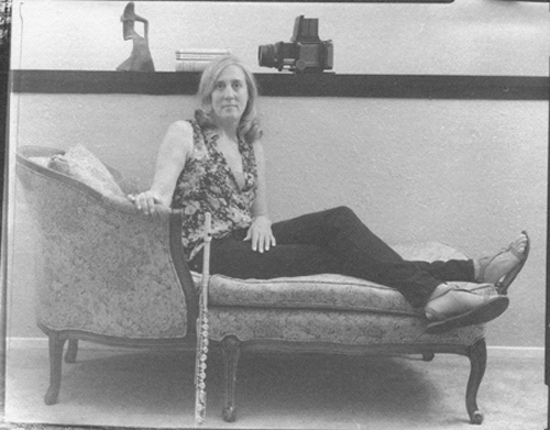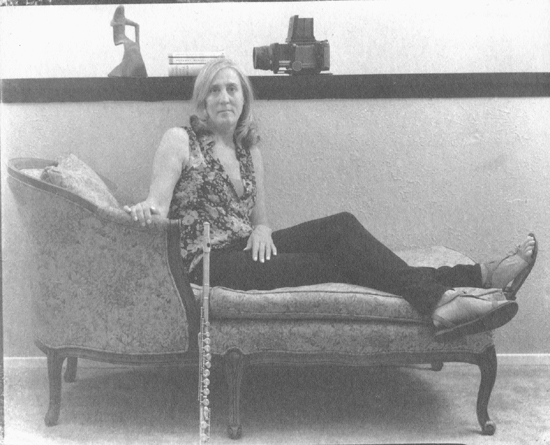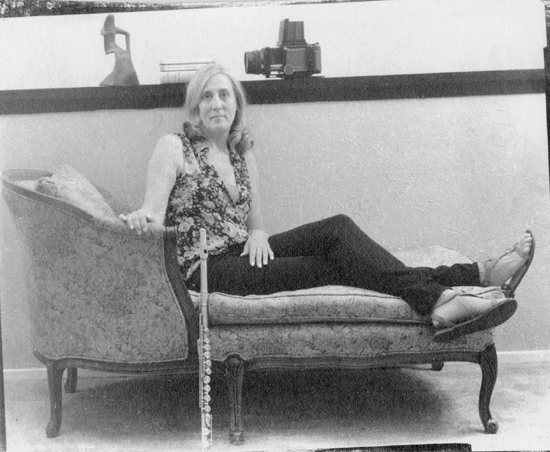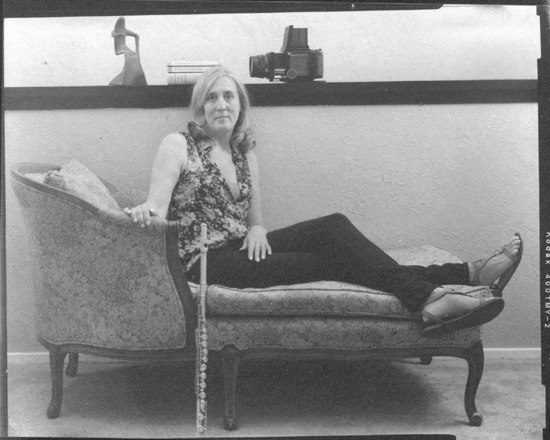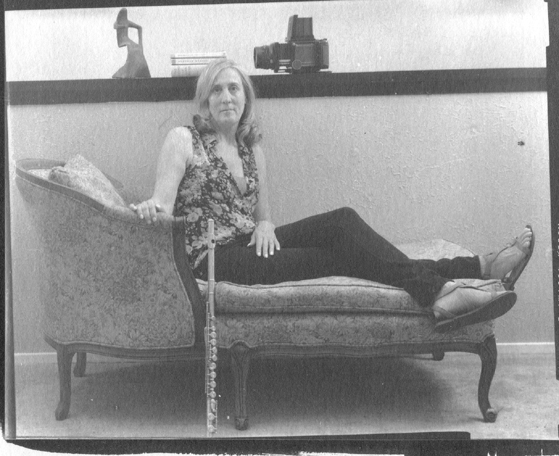|
The Texas Palladium-Platinum Process:
Notes on Dry Print Out with Platinum and Palladium
by Richard Eugene Puckett
Note: the chemicals and metals discussed in this article are toxic and should be kept out of reach of children and animals. Wear rubber or nitrile -- not latex -- gloves while working with
them. Wear a good respirator to avoid inhaling the metal particles if you mix your own platinum or palladium solutions from powder. Never use a blow dryer or fan to speed up
drying sensitized paper (because you do not humidify paper for this process, prints air dry very quickly).
Following on my Texas Chrsyotype process, in which I treat ammonium ferric oxalate with
ascorbate to print out grainless pure gold images with a latitude of 10 to 11 stops, I turned my attention to palladium- platinum. Dick Sullivan's (of Bostick & Sullivan) Ziatype process has
become possibly the most popular fine art printing process in the 21st century. The Ziatype has a long track record for yielding excellent results. However, I found the process improvable in two
ways: the humidification of paper, which is difficult to quantify and introduces a level of uncertainty in the printing process, and the limitation that no more than one third of the palladium
be replaced with platinum. The Texas Palladium-Platinum process, like the Texas Chrystoype and the Karytype (gold-platinum), replaces humidification with modification of the sensitizer. Further,
I found that by freezing and thawing a platinum solution, I could substitute platinum for at least 75% of the palladium.
Whereas 8 drops of 1% ascorbate added to 10 ml of 40% ammonium ferric oxalate works fine for printing with pure gold, platinum and palladium need a bit more coaxing to precipitate out of
solution properly in the absence of humidity. I arbitrarily doubled the strength of the ascorbate (to a 2% solution) and added the same number of drops to the 40% AF0. The results were promising,
but the images were still flat. I then began adding other chemicals to the AFO-C and quickly saw that with ferric oxalate my goal of a dry print out process for palladium and palladium-platinum
was at hand. Furthermore, I could even substitute platinum for up to 75% (or more) of the palladium. By 100% platinum, the formula changes and taming platinum's grain becomes the new
issue. (For those reasons, pure platinum print out will have to wait for a separate article.)
The chemicals I have successfully used for boosting the contrast with palladium and palladium-platinum are:
- ammonium dichromate
- ferric oxalate
- more ascorbate added to ammonium ferric oxalate
Ammonium dichromate is an extremely hazardous chemical that can induce various cancers and failure of vital organs. It also increases print out time exponentially. In my opinion, dichromates
do not belong in the darkroom. For these reasons, I do not recommend using ammonium dichromate to boost contrast.
At worst, ferric oxalate gives the print a yellow cast that easily clears. Used in combination with ascorbate-enhanced ammonium ferric oxalate, the volume of ferric oxalate can be kept to a
minimum. To do so, increase the volume of ascorbate you add to the ammonium ferric oxalate. Some negatives - those of medium to high contrast -- may not even need ferric oxalate added to the
sensitizer. This allows the printer greater control over contrast by increasing or reducing the volume of C in the ammonium ferric oxalate; the printer is therefore encouraged to prepare several
solutions of ammonium ferric oxalate-C with as few as 8 drops of 2% C to each 10 ml to as many as 14 drops of 2% C added. Low contrast negatives will always need at least one drop of ferric oxalate.
Fundamentals of the Texas Platinum-Palladium Process
The iron-based processes use ammonium ferric oxalate and a metal salt (for example, potassium palladium chloride) to form an image. On exposure to a UV light source, the oxalate releases an
oxygen atom from the iron, converting it to its ferrous state. The iron precipitates out of solution onto the paper, taking palladium and/or platinum with it. The exposed print is subsequently cleared
of the iron to leave behind an image formed entirely of the noble metal(s).
By adding 6 to 14 drops of 2% ascorbate (vitamin C) to 10 ml of 40% ammonium ferric oxalate, you create an alchemical iron that exists simultaneously in its ferric and ferrous state: AFO-C. A
print from this amalgam is self-developing during exposure on dry paper that needs no pre-humidification. Palladium (and platinum) drops out more efficiently than with the traditional damp
ammonium ferric oxalate process. In addition, for the first time -- ever -- with AFO-C one can print an image formed from gold and platinum (like pure platinum print out, the Karytype will have
to be the subject of a separate article).
Tools You Need
You need the same equipment that is used for any of the 19th century alternative printing processes:
- Synthetic (not hake) brush one-quarter to one-half the width of the negative to print (such as, 2" to 4" brush for 8x10)
- Contact print frame. (You can make one from a heavy sheet of plate glass clamped, with potato chip bag spring clips, to a split back made of plywood.)
- Tray larger than your prints
- Stirrer
- Paper towels
- Shot glass (from which you will never drink again!)
- Pencil
- Scale sensitive down to 1 gram
- Rubber or nitrile gloves (NOT latex)
- UV light source -- either the sun or a UV box
- Graduated beakers or cylinders -- one up to 25 ml and a second up to 1000 ml
- 10 ml to 30 ml transparent brown glass bottles with stoppers
- Various 1 liter bottles with air-tight caps
- Adhesive labels
- Water-resistant labeling marker
Papers You Need
Use cold pressed unsized or internally sized pure rag cotton paper. I have obtained superb platinum and palladium images on:
- Arches Platine (internally sized)
- Revere Platinum (unsized)
Of the two, I far prefer Revere Platinum 300gsm. It usually loses its stain in the first water bath, and images printed on this unsized rag cotton paper are crisp and pure. Arches Platine by contrast
has a tendency to show a hint of grain and softness in low-contrast prints made with platinum present in the palladium, and requires a stronger first acid bath followed by aggressive baths of tetrasodium EDTA and hypo clear.
The following papers should also work but are untested at this time:
- Clear Print 16 lb vellum
- Pacific Arc 24 lb vellum
- Canson C.A. Grain
- Rives BFK
- Stonehenge
- Cranes Cover
- Strathmore 500 series Bristol Plate (Tested successfully with pure platinum)
Some papers that work with the Ziatype process and with developed out platinum and palladium may not work for the Texas Platinum-Palladium process.
Tween is not appropriate for this process.
Chemicals You Need
You need the following chemicals:
- Ascorbate (pure vitamin C), available at most pharmacies, and all health food and nutrition stores. Use a 2% solution.
- Ammonium ferric oxalate crystals. 250mg of this light-sensitive chemical yields 600 ml the of 40% solution -- enough to make 1200 8X10 prints at 12 drops per print. Ammonium ferric
oxalate is quite inexpensive and is available from sources listed at the end of this article. TIP: store the container in a cool, dry, dark place. AFO is affected by UV (and fluorescent
light, as well as heat) and is highly hygroscopic.
- Tetrasodium EDTA or Disodium EDTA. Purchase at least a kilo -- use a 15% solution (150 grams to one liter of water) to clear prints made on Arches Platine; use a 5% solution for Revere Platinum 300 gsm.
- Hypo Clear in powder or liquid form, for prints made on Arches Platine. Use as instructed for clearing silver prints. Economize by mixing sodium sulfite and sodium bisulfite instead
(200 grams of sodium sulfite, 2 grams of sodium bisulfite dissolved in one liter of distilled water and diluted 1:9 for immediate use).
- Distilled water (at grocery stores and drug stores everywhere).
- Ferric oxalate (27% solution) for boosting contrast.
- Muriatic acid (~29% hydrochloric acid). Dilute 1:60 (.5%) in distilled water to clear prints on Revere Platinum paper; dilute 1:15 (2%) in distilled water for prints on Arches Platine.
Metals You Need
- 15% lithium palladium chloride or potassium palladium chloride.
- 20% ammonium platinum chloride or potassium platinum chloride (if printing platinum-palladium).
Preparing the Chemicals
Note: A 40% solution of ammonium ferric oxalate is 4 grams dissolved in enough water to total
10 ml or 40 grams in 100 ml of distilled water. A 15% solution is 15 grams dissolved in 100 ml.
Caution: wear a good dust mask when preparing solutions as accidental inhalation of any of these chemicals (except ascorbate) and metals can have serious health consequences.
- Prepare a solution of 10 ml of 40% ammonium ferric oxalate by dissolving 4 grams of the crystals in 8 ml of cool distilled water. Work in weak tungsten (not fluorescent or natural)
light. Stir vigorously until the crystals dissolve completely and top off to a total volume of 10 ml. Pour into a brown glass eyedropper bottle labeled AFO-C.
- Prepare a 2% solution of ascorbate. Dissolve 1/5th gram of ascorbate in 10 ml of distilled water or 2 grams in 100 ml. (Ascorbate sells for around $1 an ounce or less than 4 cents a
gram.) Pour into an eyedropper bottle labeled 2% C.
- Add eight drops of the 2% ascorbate solution to the 10 ml of 40% ammonium ferric oxalate solution. Recap both bottles, and shake the ammonium ferric oxalate vigorously for 5 seconds
. You now have 10 ml of AFO-C. (Note: you can add more or fewer drops of ascorbate to the AFO and still obtain good results; however, 8 yields satisfactory results.
- Prepare appropriate volumes (1 liter is a good start) and percentages of hypo clear and 15% tetrasodium (or disodium) EDTA and pour into labeled bottles.
- Pour 16 ml of muriatic acid into a large cylinder or beaker containing 984 ml of distilled water. Pour this into a bottle labeled .5% Hydrochloric Acid. This is for clearing the iron
from the print. Note: Some authors recommend citric acid as a safe alternative to hydrochloric acid. Unfortunately, citric acid is not the ideal clearing agent for Arches Platine
and Revere Platinum. Wear rubber gloves, eye protection, and mix the hydrochloric acid solution under a vent or out of doors. Tip: Keep a two-quart sauce pan (not a narrow-necked
bottle) filled with cold water within arm's reach when working with an open bottle of muriatic acid.
- Dissolve 8 grams of ferric oxalate in 30 ml of warm distilled water. Note: Ferric oxalate is notoriously difficult to get into solution; you can save yourself considerable anxiety by
purchasing it premixed from Bostick & Sullivan. Pour 20 ml into a bottle labeled 27% Ferric Oxalate.
- Add 10 ml of distilled water to the remaining 10 ml of ferric oxalate and pour this into a bottle labeled 13% Ferric Oxalate.
Contrast Control
You control contrast in three ways:
- Increase the ratio of platinum to palladium (very slight).
- Increase the ferric oxalate (very significant)
- Increase the ascorbate added to the ammonium ferric oxalate (very significant)
|
Contrast Table for 8x10 with 8 drops of 2% C Added to 10 ml Ammonium Ferric Oxalate
|
|
AFO-C
|
PT
|
PD
|
FO (27%)
|
CONTRAST
|
|
9
|
11
|
1
|
3
|
Low
|
|
9
|
6
|
6
|
3
|
Low-Medium
|
|
9
|
9
|
3
|
3
|
Medium
|
|
9
|
9
|
3
|
4
|
Medium-High
|
|
9
|
9
|
3
|
5
|
High
|
|
Note that a print that is mostly platinum displays approximately 1/3 to 1/2 stop greater contrast.
|
Contrast Table for 8x10 with 10 drops of 2% C Add to 10 ml Ammonium Ferric Oxalate
|
|
AFO-C
|
PT
|
PD
|
FO (27%)
|
CONTRAST
|
|
9
|
11
|
1
|
3
|
Medium
|
|
9
|
6
|
6
|
3
|
Medium
|
|
9
|
9
|
3
|
3
|
Medium-High
|
|
9
|
9
|
3
|
4
|
High
|
|
|
Contrast Table for 8x10 with 12 drops of 2% C Add to 10 ml Ammonium Ferric Oxalate
|
|
AFO-C
|
PT
|
PD
|
FO (27%)
|
CONTRAST
|
|
9
|
11
|
1
|
0
|
Medium-High
|
|
9
|
6
|
6
|
1
|
High
|
|
9
|
9
|
3
|
2
|
High
|
|
9
|
9
|
3
|
3
|
Extremely High
|
|
Other Print Sizes
Contrast control, and the ratio of platinum to palladium, are both obviously restricted with smaller volumes of solutions, and expanded with larger volumes. The following recommendations are
extrapolated from 4x5, 6.5x8.5 and 8x10 prints.
4 x 5 :
The number of drops is 3 AFO-C, 3 metals (combined total), and 1 FO -- or simply 3 drops of AFO-C with 12 to 14 doprs of 2% C. Obviously, the fine contrast control available with a wider
range of combinations is lost.
5 x 7 :
The number of drops is 4 AFO-C, 3 metals, and 1 FO (or just AFO-C, as above).
6.5 x 8.5 :
6 drops AFO-C, 8 metals, 1-2 FO.
11 x 14 :
12 AFO-C, 16 metals, 4-5 FO.
Increasing the Ratio of Platinum to Palladium
Platinum and palladium have nearly the same tonal range. As a general rule, printers add platinum to palladium in order to boost midtone contrast, separating out those zones in the image. Indeed,
you can observe a slight contrast boost as you use more platinum and less palladium in your sensitizer. The change is subtle. Even so, while the difference between an image containing no
platinum at all and 25% platinum is moderate; the difference between one of pure palladium and 75% platinum is significant. With this process, you can substitute as much platinum as desired for
palladium, on a drop for drop basis.
Increasing the Ferric Oxalate
In pure palladium and with platinum replacing up to half the palladium for 8x10 or 6.5x8.5, a negative that would print well on grade 2 silver gelatin paper needs about three drops of 27%
ferric oxalate (in combination with AFO-C enhanced with 8 drops of 2% C) to print out with good Dmax and Dmin. Smaller prints, 5x7 and below, typically need only one drop of 27% ferric oxalate.
Increasing the Ascorbate in the Ammonium Ferric Oxalate
Just adding more ascorbate to ammonium ferric oxalate will boost contrast significantly, but a low-contrast negative will print flat if no additional contrast agent is added. However, the more
ascorbate in solution, the less ferric oxalate you need to add to the sensitizer. The limit for this combination is that at a certain point (about 14 drops of 2% ascorbate added to 10 ml of
ammonium ferric oxalate), the ratio of ferric to ferrous iron falls to a level insufficient to keep the iron suspended in solution. The AFO-C turns a blackish green and is useless. (Olive-green is fine.
)The best useful range for ascorbate in AFO is 6 to 14 drops of 2% ascorbate added to 10 ml of 40% ammonium ferric oxalate.
Printing
To make an 8x10 print with a 1:1 ratio of platinum and palladium:
- Count 6 drops of platinum into a shot glass and place the glass in the back of your freezer. Freezing, thawing and restoring the platinum into suspension eliminates visible grain in the
print the platinum otherwise introduces. If you want a grainy print, skip this step. If you want a smooth print, do this. Tip: potassium platinum chloride freezes much faster than ammonium platinum chloride.
After about 10 minutes, set a small volume of tap water to boil.
- Sketch the outline of the negative on a sheet of paper.
- When the platinum solution has frozen solid, remove the shot glass from the freezer and place it in a small dish with enough hot water to cover the shot glass about one-third up from the bottom.
- Don rubber or nitrile gloves.
- Wet the synthetic brush thoroughly. Double two sheets of paper towel and firmly wipe the brush until it is just damp and set aside.
- When the platinum has melted, if necessary swirl it to redissolve any platinum that has dropped out of suspension.
- Count 6 drops of palladium into the shot glass. Swirl to mix the metals.
- Working in weak tungsten light, count 9 drops of 40% AFO-C into the shot glass. For a low contrast negative, instead of the AFO to which you added 8 drops of 2% C, use AFO to which
you added 12 drops of 2% ascorbate.
- Add 3 drops of 27% ferric oxalate. Swirl the liquid in the shot glass vigorously and quickly pour the sensitizer solution onto the paper inside the sketched negative area.
- Brush out the solution methodically, vertically, horizontally and diagonally across the paper. Spread the solution out evenly as fast as possible while keeping it more or less within the
outline. Tip: Perfect your brushwork on ordinary paper using water mixed with food color before trying this with the precious metals.
- Place the sensitized paper in a dark, dry, cool place for 10-15 minutes, until matte and no longer glistening when viewed at an angle in weak tungsten light.
- Place a sheet of 2 or 3 mil mylar/acetate on top of the dry paper and your negative on top of the mylar. Place this in your contact print frame.
- Expose in direct sunlight or to a UV light source. Anticipate exposures ranging from less than 1 minute to as long as 10 minutes, depending on the negative and the ratio of platinum to
palladium (pure palladium prints out fastest). Drop one half of the print frame back to view print-out progress. The image may have a heavy yellow stain from the ferric oxalate and
therefore may appear darker than it actually is. Examine the print carefully for detail in the darkest and lightest zones where you want detail. Tip: you can minimize the interference of
the stain by viewing the print through a yellow or orange filter.
- Wearing rubber gloves again, immerse the correctly exposed print in a first bath of very cold (~35 degrees Fahrenheit) tap water. This minimizes the initial darkening of the image
sometimes observed in the first bath.
- After five minutes, pour off the cold water and pour 250 ml to 500 ml of .5% hydrochloric acid into the tray. Agitate intermittently for 15 minutes.
- Pour off the acid, wash in running water for one minute and pour 15% tetrasodium EDTA into the tray. Agitate intermittently for 15 minutes.
- Pour the EDTA back into its bottle and wash the print in running tap water for one minute.
- This is an optional step if the yellow stain from the ferric oxalate still has not cleared. Pour 250 ml to 500 ml of hypo clear into the tray and agitate intermittently for 15 minutes. Save the
dilute hypo clear for later prints if you plan more for the session.
- Wash print in running water again for 5 minutes, and then in EDTA for 15 minutes.
- Wash a print on Arches Platine or Revere Platinum 300 gsm in running water for 60 minutes. Wash Revere Platinum 145 gsm or Clear Print vellum for 30 minutes.
- Drain and hang to dry. Spot the dry print with spot tone or india ink as necessary.
- The procedure for printing with a lower or higher ratio of platinum to palladium is exactly the same as above. You can print pure palladium with the same formula, simply eliminating the
steps related to platinum.
Problems and Solutions
Problem: If I add platinum to the palladium, my print is visibly grainy.
Solution: Freeze the 20% platinum solution solid in the bottom of the (mixing) shot glass, then
thaw. Tip: Potassium tetrachloroplatinate freezes much faster than ammonium hexachloroplatinate.
Problem: I humidified my paper and my print looks fuzzy and grainy.
Solution: Do not humidify paper for this process. It is not necessary and provides no benefit whatsoever.
Problem: I tried adding 12 drops of 2% ascorbate to my 40% ammonium ferric oxalate but the contrast in my print is still too low
Solution: Double or triple the number of drops of 27% ferric oxalate you add to the sensitizer, as
well. You may want to prepare a double-strength solution of ferric oxalate (I have never tried and am not sure this is possible).
Problem: My prints fade in the hydrochloric acid bath.
Solution: Your acid is too strong. For pure palladium prints, the recommended maxium strength is
.5%. Also, remember when diluting muriatic acid that its full strength is approximately 29% (I have seen it as high as 31%). If your prints continue to fade, switch to 15% citric acid, two baths
in 15% tetrasodium EDTA and a bath in Hypo Clear (at normal strength for clearing silver negatives and prints).
Problem: My prints slowly get darker and after a few weeks are almost entirely black.
Solution: Leave the print in the hydrochloric acid bath longer, and add two baths in 15%
tetrasodium EDTA and a bath in Hypo Clear (at normal strength for clearing silver negatives and prints). Make sure your final water wash is 60 minutes for heavier papers (250 gsm and heavier) and 30 minutes for lighter papers.
Problem: My prints look gritty and the image does not completely print out.
Solution: You are using an incompatible paper. The metals soaked too far into the fibers. Switch
to Revere Platinum or Arches Platine.
Problem: I get dark stains in my paper where I pour the sensitizer solution.
Solution: This is caused by too much ascorbate in the ammonium ferric oxalate. Prepare fresh
ammonium ferric oxalate and add less ascorbate.
Problem: I tried to make a print with platinum substituted for some of the palladium. Only a grainy, partial image printed out.
Solution: This is caused by "old" platinum solution (older than two months or so). You freeze and
thaw fresh (less than two months old) platinum chloride before printing with it. For old platinum chloride, place either the entire (loosely-stoppered) bottle of platinum chloride, or just a shot glass
containing the drops of platinum to be used immediately, in a tray of boiling hot water. Heat the platinum in this way for about 30 minutes, replenishing the boiling hot water as it cools.
For more information about or help with this process, contact Richard
Puckett at richardepuckett@texaschrysotype.com.
|
Sources for Supplies
Chemicals, Metals, Papers and Miscellaneous: Bostick & Sullivan, Santa Fe, NM, (www.bostick-sullivan.com) can provide almost everything specified in this article.
Freestyle Photographic Supplies, Los Angeles, CA, (www.freestylephoto.biz) stocks Arches Platine, some chemicals and many of the
miscellaneous supplies.
Artcraft Chemicals, Altamont, NY. (www.artcraftchemicals.com) sells metal salts and chemicals.
2 mil mylar rolls, synthetic brushes, paper, and Winsor & Newton gum arabic can all be bought at Hobby Lobby, (www.hobbylobby.com)
and art supply stores in general.
|
|
|
|

